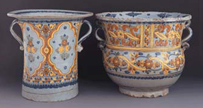|
Work
of Art: Chamber Pot
Subject
Area(s): Social Studies and Art
Lesson
Objectives:
Students
will:
- Discover
the origins of Talavera ceramics and its place in New
Spain
- Identify
the defining characteristics of traditional Talavera
earthenware
- Examine
the history behind ceramic production in Puebla, Mexico
Procedure:
Examine
the Origins of Talavera
Talavera
is a type of colorful, glazed pottery. Although production
of the ceramic has remained in Puebla, Mexico for hundreds
of years, its stylistic influences can be traced back
to a fusion of Spanish, Arabic, Chinese, and Italian
origins. It is thought that in the 15th century Spanish
monks from Puebla sent for craftsmen from Talavera de
la Reina in Spain to come and teach the people of the
region the art of working the clay so ceramic ware and
tiles could be created to decorate their monastery and
church.
1.
Have students examine this ceramic ware. Consider the
size, shape, dimensions, and features (for example,
does it have a wide mouth, a flattened rim, or handles?)
What do the students think this item was used for? Notice
the variety of colors and decoration on the surface.
Do they provide any clues?
2.
This ceramic ware is a chamber pot modeled after a popular
style in fourteenth century Spain. What advantages does
the shape of this particular vessel present?
Identify
Characteristics of Talavera Ceramics

Using
strong, intense colors such as blues, yellows, mauves,
and greens, Talavera ceramics have highly decorated
patterns and designs. The beginnings of Talavera include
a confluence of cultures ranging from Spanish to Chinese.
Cobalt blue patterns emerged in the 15th century and
had a direct influence from the Moors. The Italian influence
included the technique of applying pigments on unfired
glaze. In the mid-16th century, extensive importing
from China to Mexico brought about the similar imitations.
1.
Notice the colors used on this chamber pot. What color
combinations are used? How do the colors interact with
one another?
2.
Is this ceramic divided into panels? How do the panels
define the pattern on the pot? In what ways does this
division invoke movement in the decoration?
Curriculum Connections:
Social
Studies:
Ceramic
production in the town of Puebla was an extensive industry.
This particular example is called azul punche because
the painted decoration was applied to a blue ground.
The name derives from the Puebla candy of the same color
made for the celebration of the Day of the Dead (del
Dia de Muertos). Puebla ceramists used polychrome decoration
more frequently during the nineteenth century, marking
a departure from the blue-and-white wares that dominated
for over 150 years. Azul punche ware was so widely distributed
that shards have been found scattered throughout Mexico,
Texas, and Arizona.
Have
students learn more about the history and culture of
Puebla. Have other cultural festivals in Mexico inspired
traditional art forms? How do you think Puebla has managed
to maintain its long tradition of ceramic ware? What
kinds of traditions can you think of that take place
in the United States that have influenced artists?
Art:
Research
in greater detail the different cultures across the
Atlantic Ocean that influenced ceramic ware, specifically
Talavera. Have students study decorative motifs and
patterns from these cultures and recreate them using
a printmaking activity. Students should make note of
any distinguishing flora or fauna patterns. Have students
experiment with color, explore positive and negative
spaces, and make multicolor prints.
|